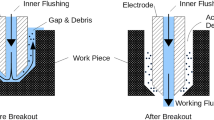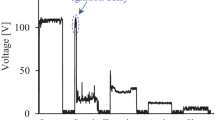Abstract
To achieve high removal rate and low electrode wear in sinking electrical discharge machining process (EDM), rough machining parameters have to be selected according to the size of the eroding surface. In general, the size of the eroding surface varies according to the depth of the machining. Thus, it has to be determined on-line. This paper shows that the electric current signal in the gap depends on the size of the eroding surface. The significance of the process attributes of the electric current signal is established by inductive machine learning and the general decision rules are derived. The size of the eroding surface can be detected on-line by monitoring and evaluating the electric current signal in the gap.
Similar content being viewed by others
References
Ishida T, Takeuchi Y (2001) L-shaped hole creation by means of electrical discharge machining and an electrode curved motion generator. Int J Adv Manuf Technol 19:260–265
Yan BH, Wang AC, Huang CY, Huang FY (2002) Study of precision micro-holes in borosilicate glass using micro EDM combined with micro ultrasonic vibration machining. Int J Mach Tools Manuf 42(10):1105–1112
Lin YC, Yan BH, Huang FY (2001) Surface improvement using a combination of electrical discharge machining with ball burnish machining based on the Taguchi method. Int J Adv Manuf Technol 18:673–682
Tsai KM, Wang PJ (2001) Predictions on surface finish in electrical discharge machining based upon neural network models. Int J Mach Tools Manuf 41(10):1385–1403
Ramasawmy H, Blunt L (2002) 3D surface topography assessment of the effect of different electrolytes during electrochemical polishing of EDM surfaces. Int J Mach Tools Manuf 42(5):567–574
Junkar M, Valentinèiè J (1999) Towards intelligent control of electrical discharge machining. Manuf Syst 29(5):453–457
Behrens A, Ginzel J (2001) An open numerical control architecture for electro-discharge machining. Proc 13th International Symposium for Electromachining (ISEM 13), 1, Bilbao, Spain, pp 161–170
Itoh T (1994) EDM apparatus current efficiency technique. Patent US 5.276.302
Itoh T (1994) Method and apparatus for sink-type electrical discharge machining with control of pyrographite bildup. Patent US 3.369.239
Kyoshi I (1982) Feeder for electrical discharge machining. Patent JP 57138544 A
Obara H (1985) Wire-cut electrical discharge machine. Patent US 4.510.367
Nakayama Y (1993) Wire electrical discharge machine and method of use Thereof. Patent US 5.243.166
Ishibashi Y, Komori A (1994) Wire electric discharge machine having alterable discharge period. Patent US 5.362.936
Rajurkar KP, Wang WM, McGeough JA (1994) WEDM identification and adaptive control for variable height components. Ann CIRP 43(1):199–202
Rajurkar KP, Wang WM, Zhao WS (1997) WEDM adaptive control with a multiple input model for identification of workpiece heigh. Ann CIRP 47(1):147–150
Liao YS, Yan MT, Chang CC (2002) A neural network approach for the on-line estimation of workpiece height in WEDM. J Mater Process Technol 121(2–3):252–258
Dehmer JM (1992) Prozeß führung beim funkenerosiven Senken durch adaptive Spaltweitenregelung und Steuerung der Erosionsimpulse, Fortscritt-Berichte VDI Reihe 2, VDI Verlag, WZL Produktionstechnik, (224), Düsseldorf
Wollenberg G, Schulze HP, Görisch A (1996) On-line determination of the working area on Sinking EDM. EDM Technology, EDM Technology Transfer, pp 7–13
Schulze HP, Wollenberg G, Läuter M (2000) Face measuring systems for parameter control of electrical discharge machining. Proc 2nd International Conference on Machining and Measurement of Sculptured Surfaces, Krakow, Poland, pp 295–304
Narumiya H, Mohri N, Saito N, Ootake H, Tsunekawa Y, Takawashi T, Kobayashi K (1989) EDM by power suspended working fluid. Proc 9th International Symposium for Electromachining (ISEM 9), pp 5–8
Kruth JP, Tonshoff HK, Klocke F (1998) Surface and subsurface of material removal processes for tool making. Proc 12th International Symposium for Electromachining (ISEM 12), Aachen, Germany, pp 1–15
Valentinèiè J, Junkar M (2001) Monitoring of the effective size of the electrode. Proc 13th International Symposium for Electromachining (ISEM 13), 1, Bilbao, Spain, pp 117–124
Yu SF, Lee BY, Lin WS (2001) Waveform monitoring of electric discharge machining by wavelet transform. Int J Adv Manuf Technol 17:339–343
Iglewicz B (1983) Robust scale estimators and confidence intervals for location, Wiley, New York
Grabec I, Sachse W (1997) Synergetics of measurement, prediction and Control. Springer, Berlin Heidelberg New York
Kononenko I (1985) The design of assistant inductive learning. Dissertation, University of Ljubljana
Quinlan JR (1986) Induction of decision trees. Mach Learn 1:81–106
Cestnik B, Kononenko I, Bratk I (1987) ASSISTANT 86: A knowledge-elicitation tool for sophisticated users. Progress in machine learning. Sigma Press, Wilmslow, UK, pp 31–45
Kruth JP, Lauwers B, Clappaert W (1992) A study of EDM pocketing. Proc 10th International Symposium for Electromachining (ISEM 10). Magdeburg, Germany, pp 121–135
Author information
Authors and Affiliations
Corresponding author
Rights and permissions
About this article
Cite this article
Valentinčič, J., Junkar, M. Detection of the eroding surface in the EDM process based on the current signal in the gap. Int J Adv Manuf Technol 28, 294–301 (2006). https://doi.org/10.1007/s00170-004-2356-4
Received:
Accepted:
Published:
Issue Date:
DOI: https://doi.org/10.1007/s00170-004-2356-4




